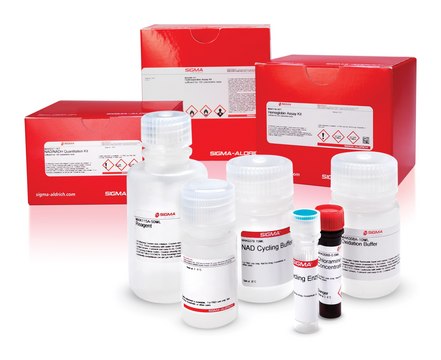N2783
Nitric Oxide Synthase, Inducible from mouse
recombinant, expressed in E. coli, buffered aqueous solution
Synonym(s):
Inducible Nitric Oxide Synthase, NOS II, iNOS, macNOS
Sign Into View Organizational & Contract Pricing
All Photos(1)
About This Item
Recommended Products
recombinant
expressed in E. coli
Quality Level
form
buffered aqueous solution
specific activity
≥4.0 units/mg protein
mol wt
130 kDa (homodimer)
130 kDa (subunit, homodimer)
UniProt accession no.
shipped in
dry ice
storage temp.
−70°C
Gene Information
mouse ... Nos2(18126)
Looking for similar products? Visit Product Comparison Guide
General description
Inducible nitric oxide synthase (iNOS), also known as inflammatory nitric oxide synthase, is a calcium independent isoenzyme, involved in synthesis of nitric oxide (NO). It is a soluble enzyme encoded by the gene mapped to mouse chromosome 11. iNOS is active in dimeric form and its activity is induced by cytokines and various other stimuli. iNOS is expressed in various inflammatory conditions.
Application
Nitric Oxide Synthase, Inducible from mouse has been used in immunohistochemical studies. It is also used to evaluate the therapeutic efficacy of inducible nitric oxide synthase (NOS) on reperfusion-induced microcirculatory alterations and hemodynamic adverse effects in the microvasculature of skeletal muscle.
Biochem/physiol Actions
NOS is responsible for the biosynthesis of nitric oxide from L-arginine. iNOS is not calcium/calmodulin dependent and has a Km = 16 μM for L-arginine.
Tumor-derived inducible nitric oxide synthase (iNOS) plays a vital role in stimulating tumor growth and vessel maturation. Therefore, it is considered to be a potential therapeutic target for anti-vascular cancer therapies. Unchecked activity of iNOS leads to overproduction of nitric oxide (NO), which is toxic for living cells. iNOS activity can be controlled at both transcription and translational level by regulating protein stability, dimerization, phosphorylation, cofactor binding and availability of oxygen and L-arginine as substrates. iNOS plays a vital role in excisional wound repair and exhibits gene therapy strategy to advance wound healing process in iNOS-deficient conditions such as diabetes and steroid treatment.
Unit Definition
One unit will produce 1.0 μmol of nitric oxide per minute at 37 °C in 50 mM HEPES, pH 7.4, containing 1 mM arginine, 1 mM magnesium acetate, 0.15 mM NADPH, 4.5 μM oxyhemoglobin, 18 μM tetrahydrobiopterin and 180 μM DTT.
Physical form
Solution in 50 mM HEPES, pH 7.4, with 10% glycerol, 8 μM tetrahydrobiopterin
Storage Class Code
10 - Combustible liquids
WGK
WGK 3
Flash Point(F)
Not applicable
Flash Point(C)
Not applicable
Choose from one of the most recent versions:
Already Own This Product?
Find documentation for the products that you have recently purchased in the Document Library.
Our team of scientists has experience in all areas of research including Life Science, Material Science, Chemical Synthesis, Chromatography, Analytical and many others.
Contact Technical Service



